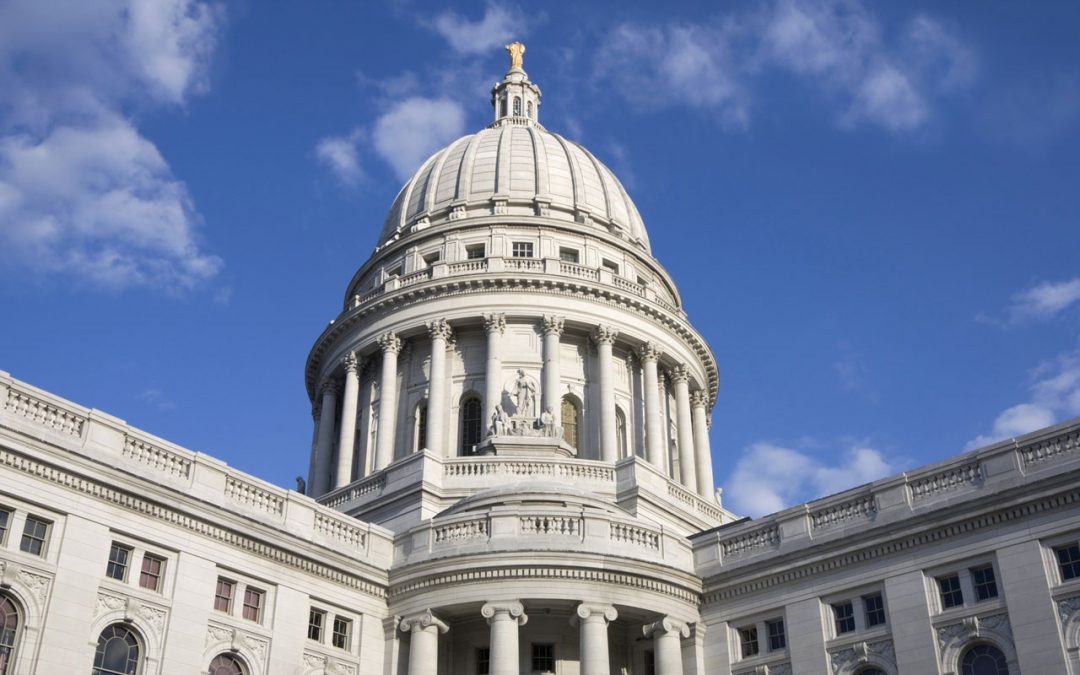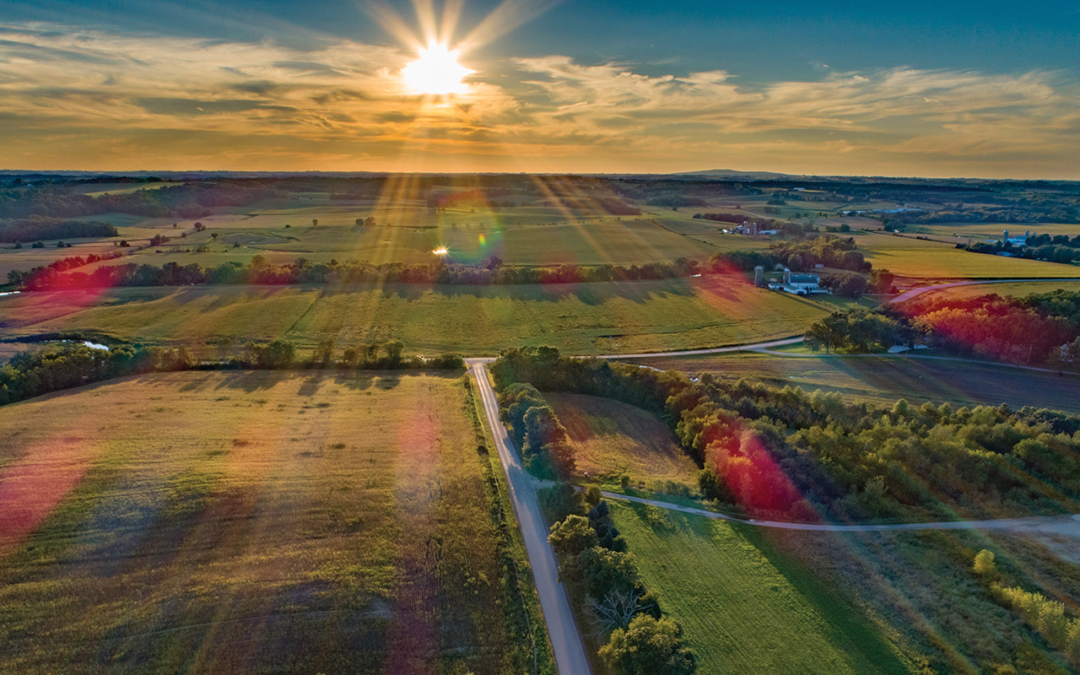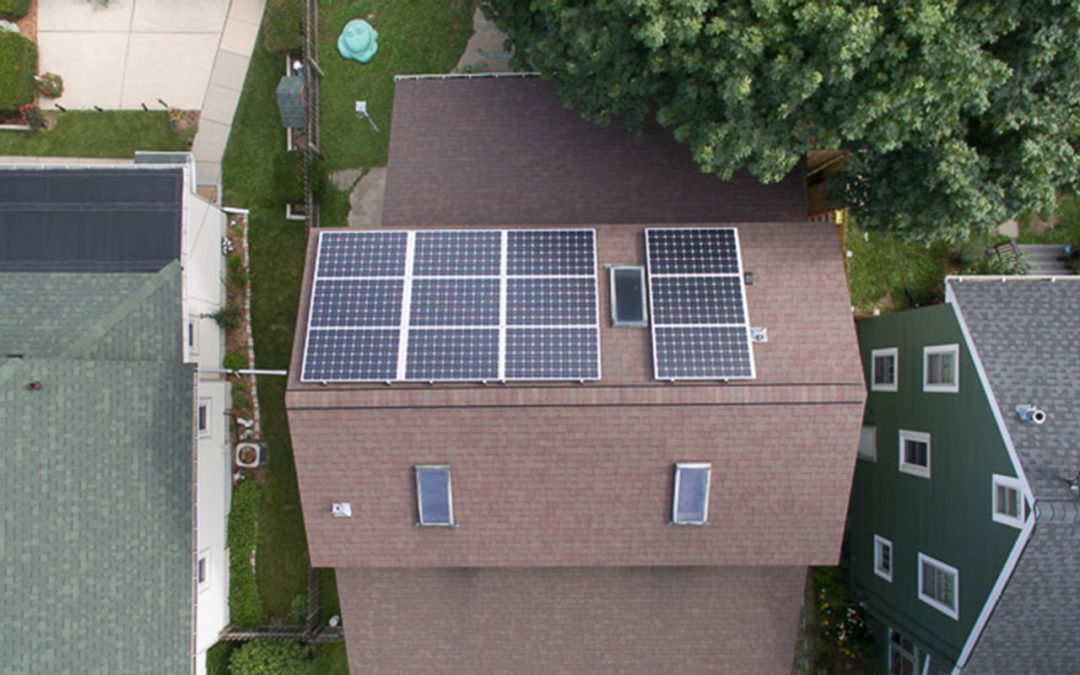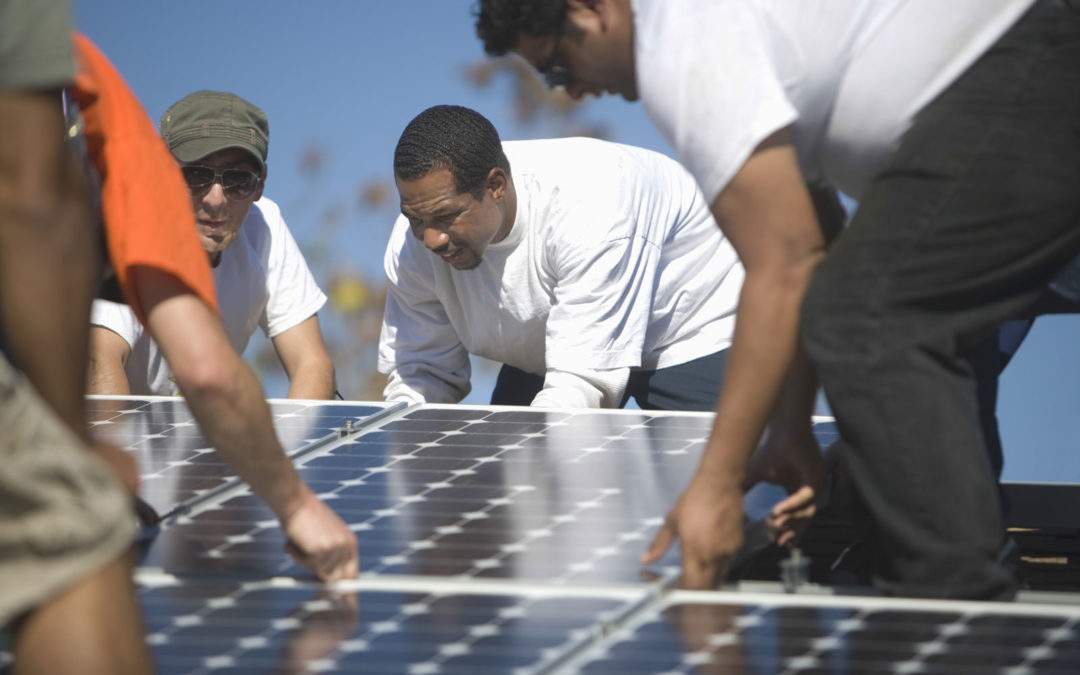
by Michael Vickerman | Jul 19, 2021 | Biogas, Policy, Programs, Renewables, Solar, Utilities, Wind
Wisconsin electric providers added significantly more renewable energy content to their electricity supplies in 2020 relative to 2019, according to a July 2021 report issued by the Public Service Commission. The annual report documents the amount of renewable electricity sold in Wisconsin and determines whether electric providers here comply with the State’s 15-year-old Renewable Portfolio Standard (RPS). This year’s report can be accessed from the PSC’s website at Docket No. 5-RF-2020.
Overall, RPS-eligible renewable energy (or renewable energy that supplies all utility customers) accounted for 12.98% of Wisconsin electricity sales in 2020, increasing more than two percentage points from the 10.71% level recorded in 2019.
This was the most significant advance since 2013 when the State’s electric providers achieved full compliance with the RPS statewide goal of 10% renewable electricity.
As shown in the chart below, the jump in Wisconsin’s renewable energy percentage resulted from a combination of increased renewable electricity supplies and a reduction in electricity sales caused primarily by the coronavirus pandemic.
In late 2020, Wisconsin utilities placed two significant renewable electricity sources in service: the Two Creeks solar farm near the Point Beach Nuclear Plant and the Kossuth wind power plant in north-central Iowa.
| Project |
Resource |
Capacity
(in MW) |
Location |
Utility owner(s) |
| Two Creeks |
Solar |
150 |
Manitowoc County (WI) |
WPS, MGE |
| Kossuth |
Wind |
150 |
Kossuth County (IA) |
Alliant-WPL |
More wind generation imported
Wind power now accounts for 71% of the renewable electricity sold in Wisconsin, and approximately 75% of Wisconsin’s wind generation originates from out of state. Overall, out-of-state sources produced 60% of Wisconsin’s RPS-eligible electricity in 2020.
While Wisconsin-based solar power is growing, it still represents a small sliver of the renewable energy pie. However, by the end of 2022, in-state solar generating capacity should surpass in-state wind capacity, as the ongoing utility effort to replace older fossil plants with new renewable generation shifts into high gear.
The pattern of adding in-state solar and out-of-state wind continues to unfold this year. Wisconsin utilities will have energized two solar farms by year’s end: the 150 MW Badger Hollow 1 project in Iowa County and the 100 MW Point Beach installation, adjoining Two Creeks. In January, a South Dakota wind farm called Tatanka Ridge began generating electricity. Dairyland Power Cooperative purchases electricity from a 51 MW share of that project.
Uneven distribution of renewable content
As shown in the table below, the distribution of RPS-eligible electricity varies widely from one electric provider to another. For example, Xcel Energy, whose territory covers much of Minnesota as well as western Wisconsin, has greatly expanded its renewable energy portfolio over the last three years, relying principally on wind power located west of the Mississippi River. As of today, one-third of Xcel’s electricity supply is renewably powered.
At the other end of the spectrum, the two WEC Energy utilities—Wisconsin Public Service (WPS) and Wisconsin Electric Power (We Energies)—remain stuck in the 5-7% range. That said, RENEW expects WPS’s renewable energy percentage to move higher in 2021, lifted by a full year of production from Two Creeks and five months of production from Badger Hollow 1.
The role of Wisconsin’s RPS – then and now
Today’s electric power industry is in a much different place than where it was in 2006 when the current RPS was adopted. Back then, renewable electricity was in its infancy, both in terms of cost and engineering performance. The purpose of an RPS, as conceived by clean energy advocates and sympathetic legislators, was to was kick-start utility deployment of renewable power sources, aimed at advancing several public policy objectives, among them resource diversity and cleaner air. Upwards of 10 wind power projects presently operating in Wisconsin and the region owe their existence to the RPS.
However, the RPS’s days as a mechanism for fueling new renewable power generation are long past. This year’s crop of solar farms and other renewable projects are the products of market forces and individual utility decarbonization plans, not the RPS. But it remains valuable as a publicly accessible information portal for tracking renewable power supplies flowing through the utilities’ bloodstream. Until the day the state legislature establishes a program for reducing carbon emissions economywide, complete with new metrics and indicators, we will continue to rely on these annual reports to find out how much progress Wisconsin electricity providers are making in their quest to decarbonize their power plants.

by Jim Boullion | Jul 15, 2021 | Advocacy, Community Solar, Electric Vehicles, Legislative Watchlist, Policy, Renewables, Solar, Utilities
When Governor Tony Evers introduced his 2021-23 Budget Bill in February, it included 28 provisions to advance clean energy and energy efficiency in Wisconsin. Among those provisions were recommendations to expand Focus on Energy, invest in the clean energy workforce, and support Wisconsin’s electric vehicle infrastructure.
Unfortunately, by the time the Governor signed the Budget on Thursday, July 8th, those 28 provisions, along with a majority of the Governor’s other initiatives, were removed from the Budget document adopted by the Joint Finance Committee (JFC) and legislature.
A number of the provisions and other clean energy bills may still be considered during the remainder of the upcoming regular legislative session. Among the proposals we expect to be considered include:
- Community Solar Expansion – Authorize the development of non-utility-owned community solar projects. Would direct the PSC to establish fair credit rates for subscribers and compensation to utilities for the use of their infrastructure and billing services. (Introduced for co-sponsorship on July 14th)
- 3rd Party Financing – Affirm 3rd party financing of solar arrays is legal.
- Direct Purchase of Automobiles – Enable electric vehicle manufacturers to sell vehicles directly to consumers in Wisconsin, either online or at manufacturer-owned facilities, without going through an independent dealership.
- EV Charging Station Grants – Allocate up to $10 million of the unspent VW Settlement funds for clean energy corridor incentives for EV charging stations.
- EV Charging Fees – Clarify selling electricity by the kilowatt-hour to EVs does not subject EV charging station owners to utility regulation.
RENEW Wisconsin will continue to work with the legislature and the Governor to advance these and other clean energy initiatives. We hope you will join us.
If you would like to talk to your legislators about any of these provisions or have other clean energy ideas that you think the State should adopt, click here to find your representatives’ contact information.
If you have any questions or comments about any of these issues, please contact Jim Boullion, RENEW Wisconsin’s Director of Government Affairs, at jim@renewwisconsin.org.

by Jeremy Orr | Jul 15, 2021 | Energy Storage, Microgrids, Solar
RENEW Wisconsin friends, don’t miss out!
The Wisconsin Office of Energy Innovation is currently accepting Requests for Proposals (RFPs) for the Critical Infrastructure Microgrid and Community Resilience Center Pilot Grant Program.
The Pilot seeks proposals that focus on innovative pre-disaster mitigation strategies through critical infrastructure microgrids and other resiliency projects, including the feasibility of distributed energy resources, storage, and grid-interactive schema.
Eligible applicants consist of Municipalities, Universities, Schools, Hospitals, and Like Entities (MUSH Market), and the Public Service Commission (PSC) has allocated up to $985,000 for the Pilot round of funding.
Applications are due Friday, August 6, 2021, by noon Central. Note that interested parties must create an Electronic Records Filing (ERF) account to submit materials. More information on how to create an ERF account can be found here.
For more information regarding the grant program, including eligible applicants and activities, please see the Critical Infrastructure Microgrid & Community Resilience Center Pilot Grant Application Instructions.

by Heather Allen | Jun 22, 2021 | Action Alert, Advocacy, Energy Storage, PSC Priorities, Public Service Commission, Solar, Utility Scale
The proposed Koshkonong Solar Energy Center would be located in southeast Dane County upstream of the Rock River. The centerpiece would be a 300-megawatt solar power generation facility anticipated to begin producing energy in 2024. Koshkonong Solar will also include a 165-megawatt battery storage component to help bolster grid reliability.
As Wisconsin continues to retire coal-fired power plants it is vital to replace those fossil fuel electricity generators with emission-free renewable energy. For example, the Columbia Energy Center, located just south of Portage, is now slated for a 2024 retirement.
Koshkonong Solar Energy Center needs vocal public support to get approved and help shift Wisconsin to clean energy. Voice your support for local solar energy by submitting a short comment today to the Public Service Commission (PSC) of Wisconsin.

Project to be located in southeast Dane County
Koshkonong Solar would advance the clean energy goals of Dane County, its local municipalities, and residents, and the State of Wisconsin. Koshkonong Solar will generate enough emissions-free electricity to power 60,000 average American homes or just about ¼ of the 240,000 households in Dane County. The project also represents exactly ¼ of the amount of solar capacity Dane County called for in its Climate Action Plan. This single project would also bring an estimated $200 million of investment including lease payments to local landowners and new revenue streams to local governments. Local governments in the project area will receive $1.2 million per year for the life of the project based on Wisconsin’s utility aid fund formula.
The developer for this project is Invenergy, which has successfully permitted other large solar farms in Wisconsin (Badger Hollow, Paris). Koshkonong, like Invenergy’s other projects, is slated to be acquired by Wisconsin utilities, including Madison Gas and Electric.
Air Quality and Carbon Emission Reduction Benefits
Koshkonong Solar will reduce CO2 emissions by between 15 and 20 million tons over its 30-year life, along with reductions in other forms of air pollution such as 12,000 tons of nitrogen oxides (NOx), 12,000 tons of sulfur dioxide (SO2), and 804 tons of particulate matter (PM2.5).
Click here for the Koshkonong Emissions Analysis.
The emissions reductions from the estimated 600,000 megawatt-hours of energy production for the project are equivalent to the carbon sequestered by 7 million tree seedlings grown for 10 years, or the avoided CO2 emissions from 2,345 railcars worth of coal burned. See other comparisons at the EPA greenhouse gas equivalency calculator.
Soil Retention and Water Quality Benefits
Koshkonong Solar will establish deep-rooted prairie vegetation amidst the arrays. This type of vegetation will increase infiltration of the site compared with current agricultural usage by (+2.2%), reduce stormwater runoff (-60% for a 1-year 24-hour rainfall event), nitrogen outflow (-48%), phosphorus outflow (-53%), and Total Suspended Solids outflow (-87%).
These upstream water quality improvements would have a positive impact on downstream environments, and yield material benefits for watershed ecosystems, human health, and recreation. Furthermore, the prairie vegetation will help turn atmospheric carbon into organic carbon, which will be deposited and build up the soil for future agriculture. Koshkonong Solar, like other solar farms, can be returned to agricultural use after the project is completed and equipment is removed, see our solar farm FAQ to learn more.
The Public Service Commission of Wisconsin is currently reviewing the project. We are asking supporters of clean energy, conservation, and climate action to submit comments sharing their support for the project. Your support would be greatly appreciated. Your voice is crucial to move the project forward and advance the clean energy transition in Wisconsin.
Submitting a message of support is easy, simply click on the link below, fill out the form, and click ‘file’. The last day to submit letters of support is July 3rd.
Click here to submit a comment in support of Koshkonong Solar!
Weighing in today will have a tremendous impact on Wisconsin’s ability to transition to clean emission-free renewable energy! Your voice matters!
Interested in learning more?
Find answers to frequently asked questions about solar farms here.
How much agricultural land would it take to power our state with solar energy? RENEW has calculated that it would take less than half a percent of Wisconsin’s total land to supply half our state’s electricity from solar. This is approximately the same amount that is currently in Wisconsin’s Conservation Reserve Program.
RENEW’s factsheet solar and agricultural land use.

by Sam Dunaiski | Jun 8, 2021 | Solar
Residential solar installations are increasing rapidly across Wisconsin. As with any growing industry, it is essential consumers are educated and know how to find responsible, reputable firms.
RENEW has provided tips for consumers when selecting a solar contractor for their home installation and has created a Solar Installers map with links to our solar installer members. However, instances of aggressive salespeople and deficient solar installations continue to grow.
In 2020, RENEW Wisconsin partnered with the Department of Agriculture, Trade and Consumer Protection (DATCP), the state’s foremost authority on consumer trade, to create consumer awareness around solar, particularly how to choose a qualified, reliable solar contractor.
DATCP has published this information on their website under Solar Power Buying Tips. The document can also be viewed and downloaded as a PDF. DATCP also provides a Consumer Complaint Form where consumers can register complaints relating to negligent solar installers.
RENEW Wisconsin thanks the Department of Agriculture, Trade and Consumer Protection for their work on this initiative. It’s reassuring to know the state of Wisconsin is officially prioritizing the protection of solar customers.

by Sam Dunaiski | May 6, 2021 | Jobs, Renewables, Solar
Today the Solar Energy Industries Association (SEIA), The Solar Foundation, and the Interstate Renewable Energy Council released the 2020 National Solar Jobs Census. While there was a 6.7% decline in the national workforce from 2019, solar jobs in Wisconsin held steady throughout 2020.
Nationally, the solar industry employed 231,474 workers in 2020. The report tracks all solar jobs in residential and utility-scale construction, as well as all supply chains, and includes anyone who spends 50% or more of their time working on solar-related activities.
While overall national solar employment dropped, the Solar Jobs Census results did show favorable numbers in specific categories. Diversity in the workforce increased, mainly among women but also among Blacks, Asians, Latinos, and Hispanics. Additionally, the Census demonstrated that pay rates for solar jobs were comparable or higher than the U.S. averages for similar occupations in energy and construction industries.
Productivity in solar showed significant growth in 2020. Record amounts of solar installations occurred last year as the total U.S. capacity increased by over 19,000 megawatts. A vast majority (73%) of the installed solar capacity was utility-scale, but residential solar productivity also increased by 19% nationwide.
Here in Wisconsin, our solar installation totals set records last year. The completion of the Two Creeks solar farm in Manitowoc County was part of over 200 megawatts of solar that came online in 2020. According to RENEW’s analysis, Wisconsin’s cumulative solar capacity more than doubled in 2020.
Wisconsin residential solar installations also increased in 2020. Over 10 megawatts of solar were installed on homes last year compared with approximately 5 megawatts in 2019. Focus on Energy saw nearly a tripling of requests for residential solar incentives, going from around 700 reservations to over 2,000. This surge in solar adoption was likely due to people spending more time in their homes, recognizing their energy consumption habits, and seeking to reduce their utility bills.
According to the Solar Jobs Census, solar employment figures in the Badger state saw a slight improvement from last year’s figures. Across the state, jobs were up from 2,871 in 2019 to 2,910 in 2020. Wisconsin is ranked #26 nationally for all solar-related employment.
While the Wisconsin job totals are reassuring, significant workforce growth is still needed. According to SEIA, “the solar industry is on a trajectory to reach 400,000 solar jobs by 2030,” but “employment will need to exceed 900,000 workers by 2035 to reach the 100% clean electricity goal set by President Biden.”
Approximately 2,450 megawatts of generation are expected to come online in Wisconsin over the next 3-5 years. We will need to scale up our solar workforce in that timeframe to complete these projects. Wisconsin’s solar industry offers an unparalleled opportunity to grow our clean energy workforce and reinvest millions in our local economies.







